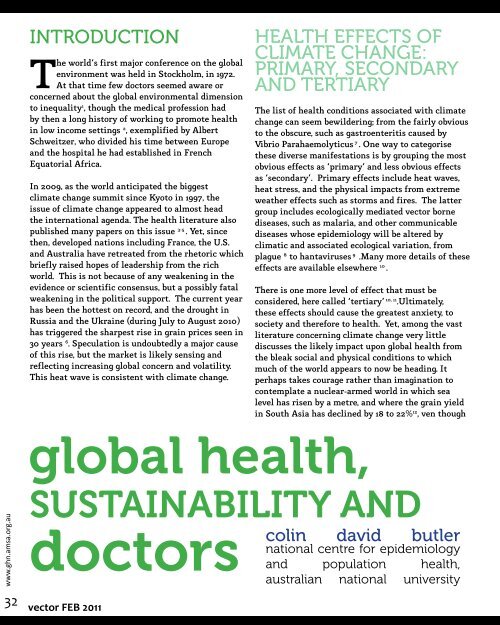You also want an ePaper? Increase the reach of your titles
YUMPU automatically turns print PDFs into web optimized ePapers that Google loves.
Introduction<br />
The world’s first major conference on the global<br />
environment was held in Stockholm, in 1972.<br />
At that time few doctors seemed aware or<br />
concerned about the global environmental dimension<br />
to inequality 1 , though the medical profession had<br />
by then a long history of working to promote health<br />
in low income settings [2 , exemplified by Albert<br />
Schweitzer, who divided his time between Europe<br />
and the hospital he had established in French<br />
Equatorial Africa.<br />
In 2009, as the world anticipated the biggest<br />
climate change summit since Kyoto in 1997, the<br />
issue of climate change appeared to almost head<br />
the international agenda. The health literature also<br />
published many papers on this issue [3-5] . Yet, since<br />
then, developed nations including France, the U.S.<br />
and Australia have retreated from the rhetoric which<br />
briefly raised hopes of leadership from the rich<br />
world. This is not because of any weakening in the<br />
evidence or scientific consensus, but a possibly fatal<br />
weakening in the political support. The current year<br />
has been the hottest on record, and the drought in<br />
Russia and the Ukraine (during July to August 2010)<br />
has triggered the sharpest rise in grain prices seen in<br />
30 years [6 . Speculation is undoubtedly a major cause<br />
of this rise, but the market is likely sensing and<br />
reflecting increasing global concern and volatility.<br />
This heat wave is consistent with climate change.<br />
Health effects of<br />
climate change:<br />
primary, secondary<br />
and tertiary<br />
The list of health conditions associated with climate<br />
change can seem bewildering; from the fairly obvious<br />
to the obscure, such as gastroenteritis caused by<br />
Vibrio Parahaemolyticus [7] . One way to categorise<br />
these diverse manifestations is by grouping the most<br />
obvious effects as ‘primary’ and less obvious effects<br />
as ‘secondary’. Primary effects include heat waves,<br />
heat stress, and the physical impacts from extreme<br />
weather effects such as storms and fires. The latter<br />
group includes ecologically mediated vector borne<br />
diseases, such as malaria, and other communicable<br />
diseases whose epidemiology will be altered by<br />
climatic and associated ecological variation, from<br />
plague [8] to hantaviruses 9] .Many more details of these<br />
effects are available elsewhere [10] .<br />
There is one more level of effect that must be<br />
considered, here called ‘tertiary’ 10, 11 .Ultimately,<br />
these effects should cause the greatest anxiety, to<br />
society and therefore to health. Yet, among the vast<br />
literature concerning climate change very little<br />
discusses the likely impact upon global health from<br />
the bleak social and physical conditions to which<br />
much of the world appears to now be heading. It<br />
perhaps takes courage rather than imagination to<br />
contemplate a nuclear-armed world in which sea<br />
level has risen by a metre, and where the grain yield<br />
in South Asia has declined by 18 to 22% <strong>12</strong> , ven though<br />
global health,<br />
www.ghn.amsa.org.au<br />
32<br />
sustainability and<br />
doctors<br />
vector FEB <strong>2011</strong><br />
colin david butler<br />
national centre for epidemiology<br />
and population health,<br />
australian national university

















